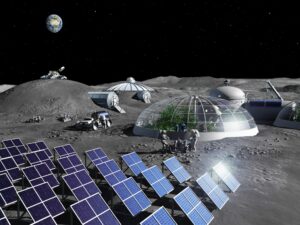by Christophe Bosquillon

The session ‘Making the Moon Work: Governance and Safety in a New Environment’ took place in the afternoon on the second day of ‘The 4th Summit for Space Sustainability’ held in London on June 22nd-23rd, and organized by the Secure World Foundation (SWF). SWF’s hot topic to not junk-up space with waste and debris is as much a concern on the Moon as in Earth orbit. Yet, what was really different in this session is that it turned out to be a candid conversation about lunar governance issues other than debris, that needed to be tackled for upcoming Moon activities.
The Secure World Foundation: a strong actor of the lunar governance public discourse
Session moderator Christopher Johnson, a space law advisor at SWF, reminded the audience that only recently did SWF turn its focus toward the Moon, and the timing is right. SWF is traditionally known for covering security and deconfliction issues in Earth orbit in a non-escalatory fashion for civilian and military affairs: SWF has for example intervened notably at conferences held by the Law, Technology, and Warfare Research Cell at the U.S. Air Force Academy in Colorado (U.S.).
Recently, SWF has led the conversation on environmental impact and sustainability in Earth orbit, however its focus gradually expanded toward the Moon. In 2019 for example SWF, together with Open Lunar Foundation, hosted a workshop on norms of behaviour in space. Currently, SWF has also been involved with the activities of the Moon Village Association and of the Global Expert Group on Sustainable Lunar Activities, where it contributes to the framing of Moon issues and their potential solutions.
As lunar missions are set to accelerate exponentially in the coming decades, the need becomes acute to develop and implement effective governance principles for lunar activities- a complex task that implies commercial, exploration, scientific, and national security drivers across the board. Beyond security, safety, sustainability, and principles of responsible governance, the global community needs also to carefully consider international coordination and inclusiveness through access to lunar activities across all stakeholders. Agencies and established space powers, but also emerging space-faring nations, the private sector, and the public are all concerned regarding how the Moon will be administrated.
US and ESA Moon cooperation
Philip Metzger, planetary scientist at the University of Florida, co-founder of the innovation lab Swamp Works and formerly a senior research physicist at the NASA’s Kennedy Space Center, made the case for Moon polar water and the necessity to tackle many coordination issues, such as the balancing act between Moon geological and scientific studies vs its economic utilization, or, the de facto presence of several international actors in the same place at the same time. Laura Delgado Lopez, a senior policy analyst at NASA’s Office of Technology, Policy, and Strategy, and a member of the SWF advisory committee, reasserted that a US leadership via the Artemis program is intended not only for the Moon but for all celestial bodies, which is actually what is written in the Artemis charter. Angeliki Kapoglou, part of the strategy and innovation team at the European Space Agency, brought to light that ESA is not only a partner in Artemis through Orion, the European Service Module, and Gateway, but it also has projects of its own.
EL3, the European Large Logistic Lander, is a robotic lander that can deliver a combination of cargo items, including scientific payloads and small robotic assets (rovers) but not humans, and can potentially become one of ESA’s contribution to Artemis surface operations. European astronauts might land with the help of NASA via the Artemis program. The EL3 would then be a “barter element” for such agreement. This is something ESA are working towards and needs to be confirmed after CM22 when ESA Member States will decide to fund or not the development.
Looking at the UK side, Nelly Offord, business line manager at UK firm SSTL (Surrey Satellite Technology Limited), has been working on the realisation of SSTL’s ambitious Lunar Communication and Navigation services, which is on track to be operational from 2024 onwards.
Meanwhile, ESA has been developing the Moonlight program for comms and PNT to support lunar exploration. To that effect, ESA signed up to buy services from SSTL’s Lunar Pathfinder, the first commercial lunar telecommunications relay satellite available for users worldwide. Furthermore, NASA will deliver Lunar Pathfinder to lunar orbit through the Commercial Lunar Payload Services initiative and ESA will provide NASA with access to lunar telecommunications. ESA, NASA and SSTL will conduct signals, laser, and satnav tests as a step closer to Moonlight becoming a reality. All this suggest that the cooperation between the US and ESA members, including the U.K., is working just fine.
Don’t shout “fire” in a crowded Moon crater
Yoav Landsman, Founder and CEO of Moonscape [ https://www.moonscape.space/ ] brought his fairly no-nonsense assessment of the main problem of these coming years and decade: everyone will land in the same place, and won’t venture very far early on. It will get crowded. Missions may not know who their neighbour is. If someone installs solar panels on a crater’s “peak of eternal light” and someone else builds some kind of infrastructure that casts a shadow on the panels, can we sue them? This kind of friction will likely happen, so we need to ask ourselves how do we coordinate missions beforehand and establish safety zones in practice (something Landsman had the opportunity to discuss at an MIT event.
How safe is safe distance?
Back to physics classroom for a minute, Metzger highlighted the fact that spacecrafts landing on the Moon eject gases at speeds 30-50% faster than Moon escape velocity, due to the Moon gravity being 1/6 of Earth. So even if gravels and big particles move slower, there’s nowhere safe on the Moon to prevent a shower of particles and dust. This suggests the need of developing landing pads that have protective berms (and/or a vacuum below the pad surface that can absorb some of the ejection). It also hints to another problem: what happens when ejection’s particles contaminate, say, polar lunar ice or regolith that need to be scientifically studied before being excavated and used commercially? We have not figured this out.
The necessity to register activities
Landsman recounted the story of tardigrades that were, together with “the DNA of some people”, stowaway passengers on board of a payload that was part of the Beresheet Moon landing back in 2019. The presence of biological contamination indicates the absolute necessity of transparently registering payloads. And not only that. The Registration Convention, that currently covers only “objects”, should be upgraded and include full and transparent registration of “activities” and their related datasets.
This was the reason behind the launching of the Registration Project supported by the Moon Village Association’s Adaptive Governance working group: an enhanced registration approach implies leveraging technology and data, and sharing data insights. Registration and licensing would also allow careful balancing of scientific and commercial activities.
The Moon polar water business case
Metzger made the case for the viability and priority of using Moon polar ice as water (oxygen and hydrogen) for propellant, and, more widely, on the fact the space domain means growth: the goal is for humanity to expand as a multi-planetary species. It is important to highlight however that other approaches want to prioritize small extraction of Moon regolith oxygen elsewhere rather than at the poles, oxygen being a by-product of extracting other Moon metals (ilmenite, etc.). And because lunar ice requires serious infrastructures and more complex financial and business deals, the extraction of lunar ice is a slow-growing project. Some say, though, we should first diminish our consumption of resources on Earth through negative growth rather than focus on implementing growth by extracting even more Moon water. This is an understandable point, and yet, given a choice, we’d rather go “Jack Sparrow” and sail through cislunar space and the Moon, the Canary Islands of the Solar System, rather than commiserate down here.
Regulatory clarity, international coordination, and global inclusiveness matter
All panelists hammered the need to balance regulatory clarity, international coordination, and global inclusiveness. Regulations can actually be a boon for investment if they clarify rather than confuse or deter. True, we may end up with a Moon duopoly, like, the “Artemis Countries” led by NASA-ESA, the “ILRS Countries” led by CNSA-Roscosmos, and other stakeholders in between. But still, as we build sustainable Moon governance frameworks, it is possible to agree with Landsman about the need to have everyone at the table, starting with China. Furthermore, the global inclusiveness aspect starts from leading countries allowing insights disclosure toward emerging nations, and, more broadly, to establish a number of frameworks for access and benefit sharing of lunar activities and outputs. So that we may evolve from an exclusive “space club” mentality to a more inclusive “space network”.
The elephant in the room: Moon affairs at the intersection between governance and “Lawfare”
Besides the details discussed during the panel, a Moon-governance-at-large discourse should be somehow addressed. Environmental impact mitigation and sustainability have increasingly influenced the space and lunar governance public discourse. So has inclusiveness. It seems difficult however to maintain a division between safety, sustainability, and civilian inclusiveness on one hand, and security, weaponization and militarization of the space domain. In other words, the two sectors in the space domain are profoundly and dangerously interconnected, and this has profound implications on how we formalize, translate, reconcile, and implement resilience and deterrence across strategic cultures. And for a moment, just think how the “harmful interference’ of hacking and disabling life support systems, a major nuisance on Earth, could mean an immediate death sentence on the Moon.
NGOs, and whomever works in the field of influencing the space and Moon regulatory public discourse are themselves actors of such “Lawfare” (where “Lawfare”-as per definition of Michael J. Listner– means the regulatory mechanisms used to balance, complement, support, impede, or constrain military and civilian action). That should give us even more pause in coordinating space behaviour globally and responsibly, regardless of decisions made by governments about their civilian-military matrix.

Currently based in Europe, Christophe Bosquillon operated globally out of the Indo-Pacific for the best part of the past decades. With a techno-economic background in non-space industries, as well as international affairs and foreign direct investment, Chris maintains a long-standing interest in old and new space, also from a security and policy standpoint. A decade ago, he developed a ‘Legal Hacker’ interest in the digital transformation governance field, data rights, computational law, and composable governance. Founder of Autonomous Space Futures Ltd., Chris, an experienced corporate boss and business owner, focuses on solutions to develop business cases in and beyond orbit: value propositions TRL-realistic over time, commercially credible, financially sustainable, legally implementable ; optimizing open data and registration in a context of adaptive governance for peaceful and sustainable space activities. While fixing the investee-investors relationship, value creation, and funding processes, Chris currently works out on the steep learning curve of space law, governance, and diplomacy, with the help of diverse friends from all over our precious blue planet.





